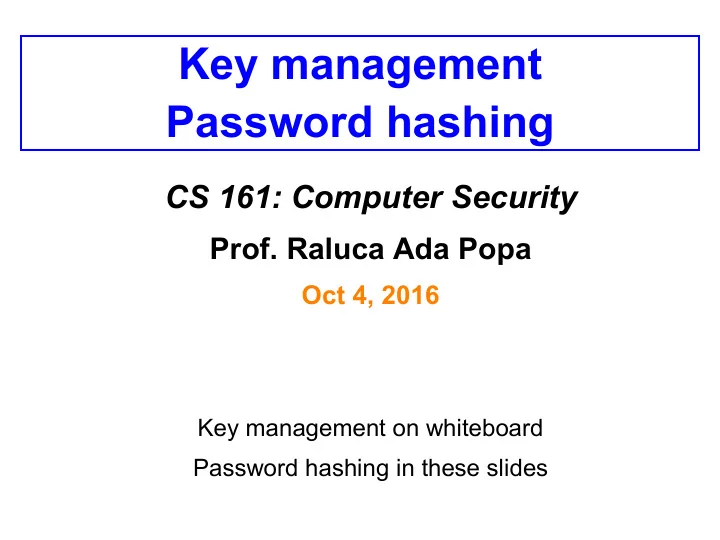

Key management Password hashing CS 161: Computer Security Prof. Raluca Ada Popa Oct 4, 2016 Key management on whiteboard Password hashing in these slides
Announcement • Project 2 part 1 due today
Passwords Tension between usability and security choose random and choose memorable long passwords (hard passwords to guess)
Attack mechanisms • Online guessing attacks – Attacker tries to login by guessing user’s password • Social engineering and phishing – Attacker fools user into revealing password • Eavesdropping – Network attacker intercepts plaintext password on the connection • Client-side malware – Key-logger/malware captures password when inserted and sends to attacker • Server compromise – Attacker compromises server, reads storage and learns passwords
Defences/mitigations Network eavesdropper: • Encrypt traffic using SSL (will discuss later) Client-side malware: hard to defend • Use two-factor authentication • Intrusion detection mechanisms – detect malware when it is being inserted into the network • Various security software (e.g., anti-virus)
Mitigations for online-guessing attacks • Rate-limiting – Impose limit on number of passwords attempts • CAPTCHAs: to prevent automated password guessing • Password requirements: length, capital letters, characters, etc.
Mitigations for server compromise • Suppose attacker steals the database at the server including all password information • Storing passwords in plaintext makes them easy to steal • Further problem: users reuse passwords at different sites! Don’t store passwords in plaintext at server!
Hashing passwords • Server stores hash(password) for each user using a cryptographic hash function – hash is a one-way function username hash of password Alice hash(Alice’s password) Bob hash(Bob’s password) • When Alice logs in with password w, server computes hash(w) and compares to Alice’s record
Password hashing: problems • Offline password guessing – Dictionary attack: attacker tries all passwords against each hash(w) – Study shows that a dictionary of 2 20 passwords can guess 50% of passwords • Amortized password hashing – Idea: One brute force scan for all/many hashes – Build table (H(password), password) for all 2 20 passwords – Crack 50% of passwords in this one pass
LinkedIn was storing h(password)
Password cracking software Cain and Abel THC Hydra Brutus
Prevent amortized guessing attack • Randomize hashes with salt • Server stores (salt, hash(password, salt)), salt is random • Two equal passwords have different hashes now • Need to do one brute force attack per hash now, not one brute force attack for many hashes at once
Salted hash example Server stores : username salt hash of password Alice 235545235 hash(Alice’s password, 235545235) Bob 678632523 hash(Bob’s password, 678632523) Attacker tries to guess Alice’s password: Computes table ‘aaaaaa’ hash(’aaaaaa’, 235545235), ‘aaaaab’ hash(’aaaaab’, 235545235), … ‘zzzzzzz’ hash(’zzzzzz’, 235545235) This table is useless for Bob’s password because of different salt
Increase security further • Would like to slow down attacker in doing a dictionary attack • Use slow hashes = takes a while to compute the hash • Define H(x) = hash(hash(hash(…hash(x)))) use with x = password || salt • Tension: time for user to authenticate & login vs attacker time • If H is 1000 times slower and attack takes a day with H, attack now takes 3 years with F
Conclusions • Do not store passwords in cleartext • Store them hashed with salts, slower hash functions better
Recommend
More recommend